53 Thought-Provoking Photographs, As Shared By The Environmental Photographer Of The Year 2022 Competition
Posted by admin on
Climate change is having a profound impact on our world, causing widespread destruction through events such as fires, floods, and intense storms. The ramifications of a changing climate are being felt globally, leaving many wondering what the future holds. Despite warnings from experts and advocates, it seems that many are still not heeding the call to take action and reduce their carbon footprint. Perhaps it will take more than words to drive home the urgency of the situation. Images of the devastating effects of climate change might be the wake-up call needed to inspire change and protect our planet.
Having taken place yearly for 15 years, the Environmental Photographer Of The Year (EPOTY) competition showcases some of the world’s most inspirational environmental photography, as well as "provides an international platform to raise awareness for the issues that put our planet at risk." Scroll down to see the EPOTY winners of 2022! If you're interested, check out the best shots of the 2021 contest here.
More info: epoty.org | Instagram | twitter.com | Facebook
#1 "Home Of Night Herons" By Gu Guanghui, 2021
Ninghai County, China "This solar power plant along the coast of Zhejiang Province is a protected area. Because there is no human interference, it has become the home of birds. The project combines underwater fish breeding and surface power generation. The ecological environment is good, attracting a large group of night herons to live on the photovoltaic panel, where they live and breed."
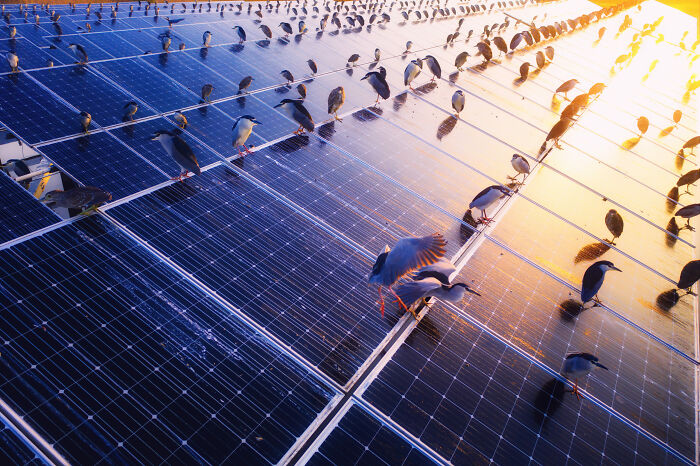
Image credits: epoty.org
The title of the Environmental Photographer of the Year 2022 went to Mehdi Mohebi Pour for his photograph "The Bitter Death of Birds". 16-year-old Fayz Khan won the Young Environmental Photographer of the Year 2022 award for "Beautiful But Hostile Colours on Earth".
Additional winners were recognized in four categories:
- Vision of the Future: "Vertical Farming" by Arie Basuki, 2022
- Recovering Nature: "Naturalia: Chronicle of Contemporary Ruins" by Jonathan "Jonk" Jimenez, 2021
- Keeping 1.5 Alive: "Chemical Explosion" by Subrata Dey, 2022
- Adapting for Tomorrow: "New Ways To The Future (III)" by Simone Tramonte, 2021
#2 "Bee-Friendly Busstop" By Shamira Van Veenendaal, 2022
Utrecht, The Netherlands "I took my camera and went out in my own city - densely populated with buildings, infrastructure and transport. Utrecht built 300 bus stops with sedum roofs to make the city more sustainable, clean and healthy. These bus stops can filter the air through the sedum, which improves the air quality. The green roof provides cooling on hot days and the plants collect rainwater that is slowly released back into the sewer so that there is less flooding during heavy rainfall. Combined, the 300 roofs increase biodiversity in the city, especially for insects such as butterflies and bees."
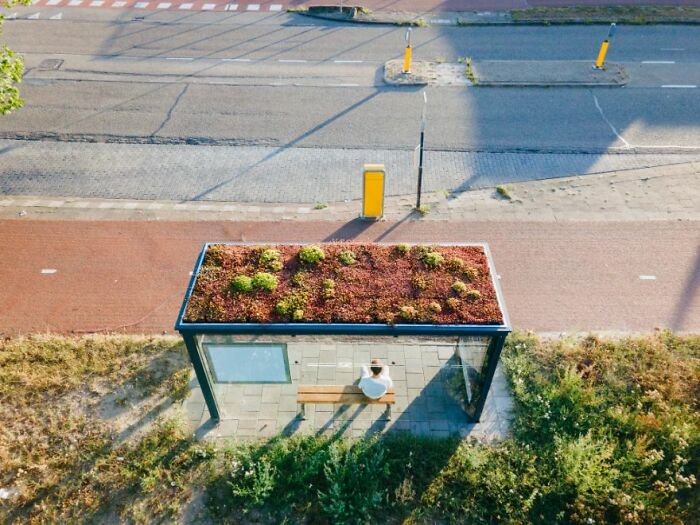
Image credits: epoty.org
#3 "One With Nature" By Bernard Kalu, 2021
Glasgow, Scotland "People join in the protest to inspire action to mitigate the looming climate crises. I am Nigerian and was one of the designated observers representing my country in COP26. There were myriads of photographers and videographers there as all the people marched in protests."
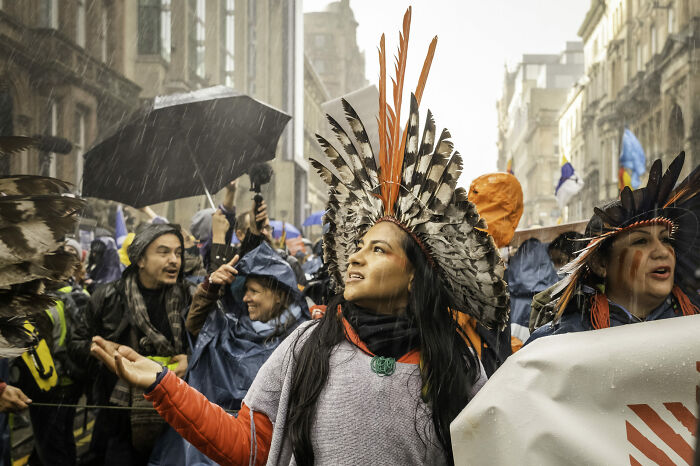
Image credits: epoty.org
#4 "Chemical Explosion" By Subrata Dey, 2022
Sitakunda, Bangladesh "A chemical explosion and fire at BM container depot Sitakunda upazila of Chittagong on 4th June 2022. 49 people were confirmed dead in the blaze, and the mixing of chemicals in the air and water has a devastating effect on the environment. The explosion at the depot spilled plastic containers into the nearby river, where the chemical-laced water entered the aquifer and destroyed the freshwater supply."
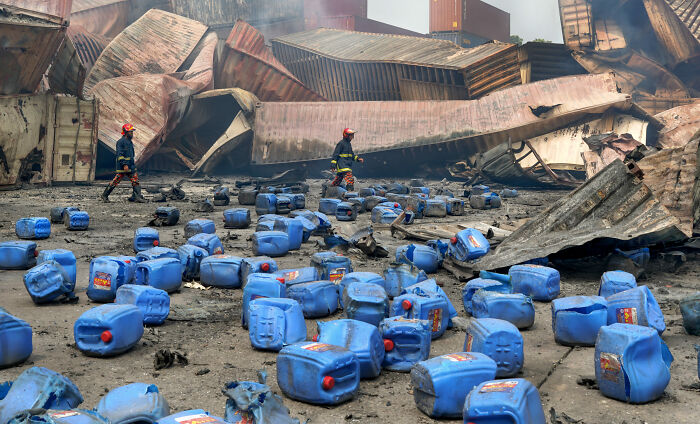
Image credits: epoty.org
#5 "Art Of Flamingos" By Lalith Ekanayake, 2022
Gulf of Mannar, Sri Lanka "A flock of flamingos wades through the algae-rich waters in a dark muddy lagoon, which is almost black. I flew the drone a few kilometers into the lagoon about 200 meters above sea level with zero disturbance to the flock. Greater flamingos (Phoenicopterus roseus) migrate to Sri Lanka, mainly on the north and north central coastal lines and lagoons. They feed on algae-rich waters and shrimps, which used to be abundant but shrunk rapidly due to human invasion. It was a surprise that the flamingos arrived this year in large numbers, as they were gradually declining over the last few years."
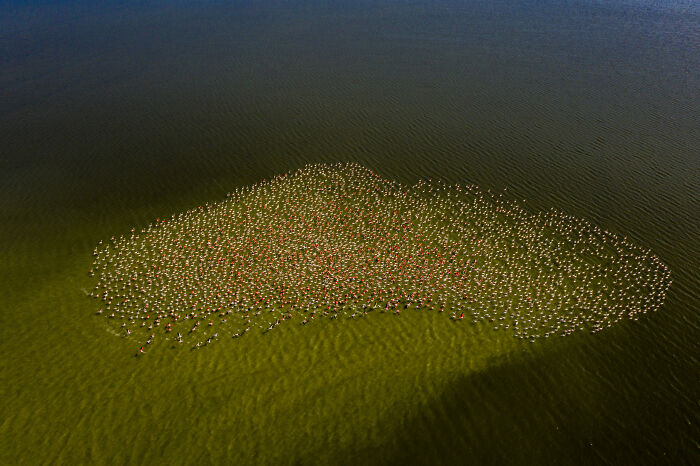
Image credits: epoty.org
#6 "Environment-Friendly Construction Under The Ground" By Md Shafiul Islam, 2022
Gaibandha, Bangladesh
"We have to think creatively to survive extreme temperatures and adverse weather conditions. The Friendship Center in the Gaibandhar district is an exceptional establishment. Built in 2012, the facility is underground. There are small ponds and trees to keep the environment cool. The roofs are covered with green grass, so the rooms remain cool. Its architect, Kashef Mahbub Chowdhuri, has received the Aga Khan Award for Architecture from Switzerland."
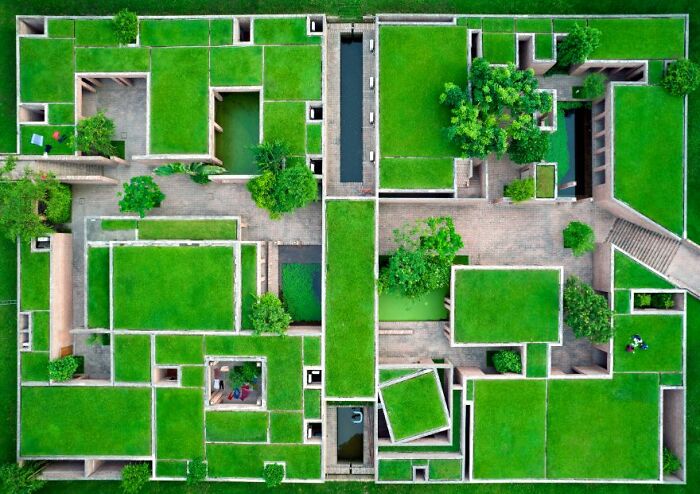
Image credits: epoty.org
#7 "The Pollution Crisis In Bangladesh" By Kazi Md. Jahirul Islam, 2022
Chittagong, Bangladesh "People start fires in garbage dumps to find the iron pieces that remain, which they can sell on the market. The burning plastic generates smoke and gas. I often go to this garbage dump to take photos. This man collects different kinds of iron pieces or breakers from the garbage heap to sell them. Air pollution in Bangladesh is the worst in the world, reducing the average Bangladeshi life expectancy by 6.7 years. Another study estimates there were 24,000 premature deaths as a result of air pollution in Bangladesh."
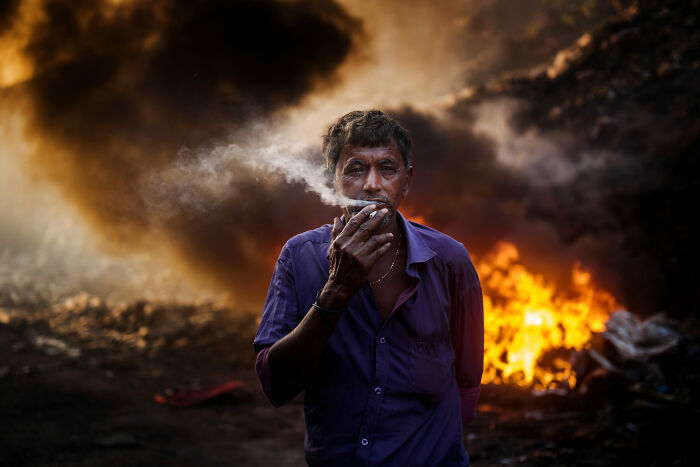
Image credits: epoty.org
#8 "An Army Of Flamingos" By Mehdi Mohebi Pour, 2022
Miankaleh, Iran "In 2019/2020 and 2020/2021, thousands of birds died in the lagoon, and in the next year, 2021/2022, fortunately, we saw the return of birds. The birds are in the wetland from the beginning of October to the end of March and after that, they migrate. The birds were our guests at the end of 2021 and the beginning of 2022, and this story is repeated every year. In 2020/2021, tens of thousands of migratory birds died in this wetland, and in the following year (2021/2022), the flock returned."
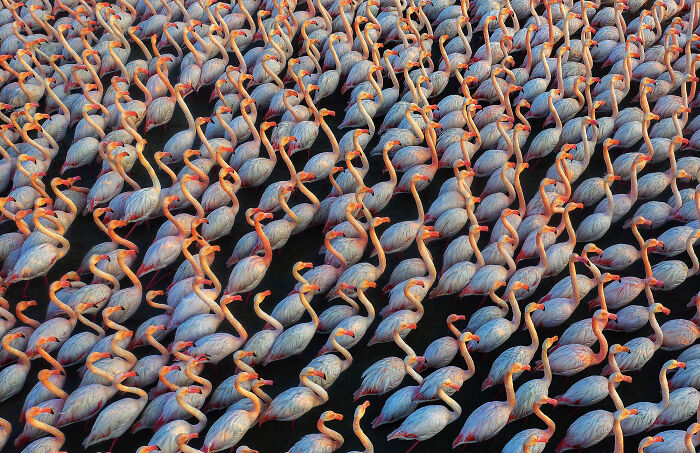
Image credits: epoty.org
#9 "Always A Little Further....." By Nigel Wallace-Iles, 2021
Mount Everest, Nepal "This image was captured on an Everest Base Camp Trek. As we were leading into BC, we stopped for a moment to allow the Sherpas to pass with their convoy of yaks, taking the supplies of LPG to the main base camp. The image, for me, captured the juxtaposition of what we as humans are capable of achieving with determination, and the damage we do in pursuit of those achievements. It was a poignant moment for me considering the pristine environment we were in and also highlighted the intricate interconnected nature of development, poverty within the Sherpa communities, equality, security and climate action. It also made me question why, and how, we are able to focus so hard on achieving certain things and yet so many are unwilling to accept the unprecedented effort required from all sectors of society to address the defining issues of our time."
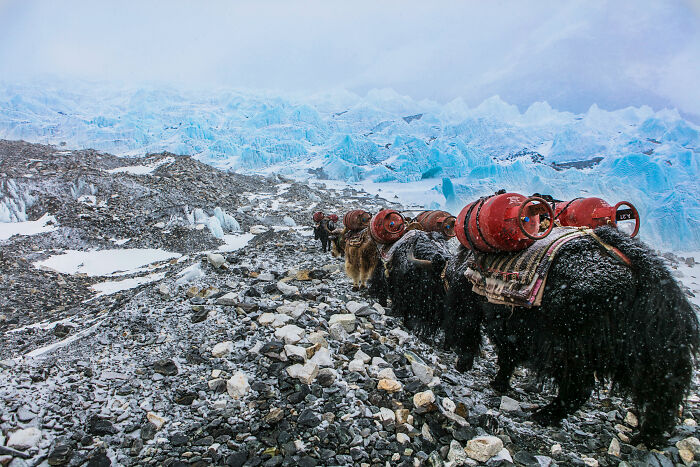
Image credits: epoty.org
#10 "The Patterns Of Las Vegas" By Jassen Todorov, 2021
Las Vegas, USA "More than two million people call this city in the Mojave Desert home. Las Vegas is the driest major city in the U.S., and Nevada is the driest U.S. state. The nearby Lake Mead is well below its capacity due to severe drought in the Southwest, as well as ever-increasing water demand. Now in the 21st century, should we rethink building expansive cities in dry deserts? And are these places sustainable in the long term? This image was taken while I was flying my single-engine Piper Warrior plane."
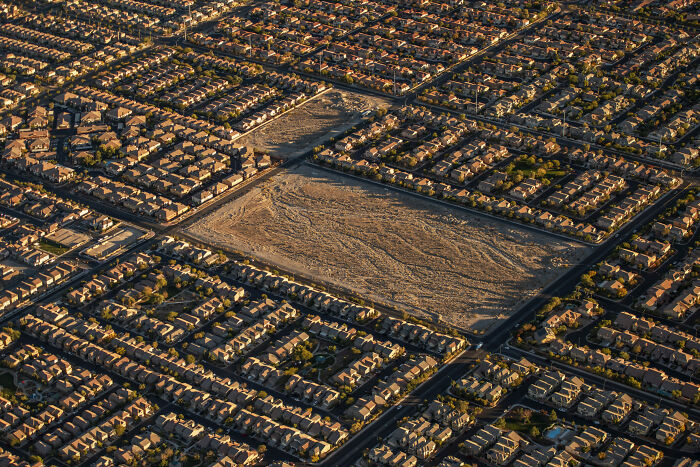
Image credits: epoty.org
#11 "The Climate Change Effect" By Solayman Hossain, 2021
Kushtia District, Bangladesh "During the monsoon season, the river rises and the village is flooded. The flood also means there is a shortage of food for the animals, which have to be guided to look elsewhere."
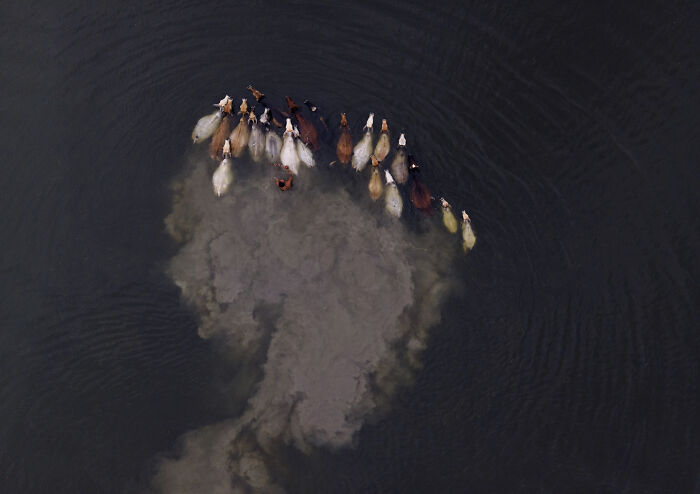
Image credits: epoty.org
#12 "Papa Potwe, 1." By Danielle Stanley, 2021
Mafia Island, Tanzania "Ali has been working at Kitu Kiblu for over 8 years and has learned to respect these gentle giants. This photograph was taken after many attempts to remove a hook and fishing line from the mouth of a Whale shark. Although a small fishing line doesn't encompass the greater issues of unsustainable fishing industries, it represents the power of conservation to bring about positive change through nature-based solutions, specific to conservation."
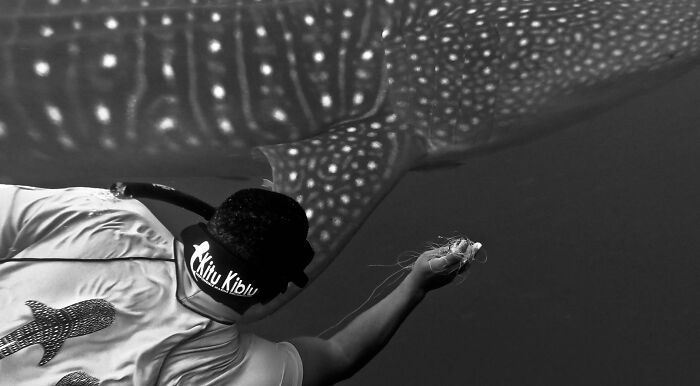
Image credits: epoty.org
#13 "The Bitter Death Of Birds" By Mehdi Mohebi Pour, 2021
Miankaleh, Iran "In 2019/2020 and 2020/2021, thousands of birds died in the Miankala lagoon due to lack of water and its contamination with various toxins. This photo shows the efforts of the environmental forces to collect the bodies and prevent the spread of this disease. In the next year, 2021/2022, fortunately, we saw the return of birds. The birds are in the wetland from the beginning of October to the end of March and after that, they migrate and we can photograph them for almost 6 months of the year."
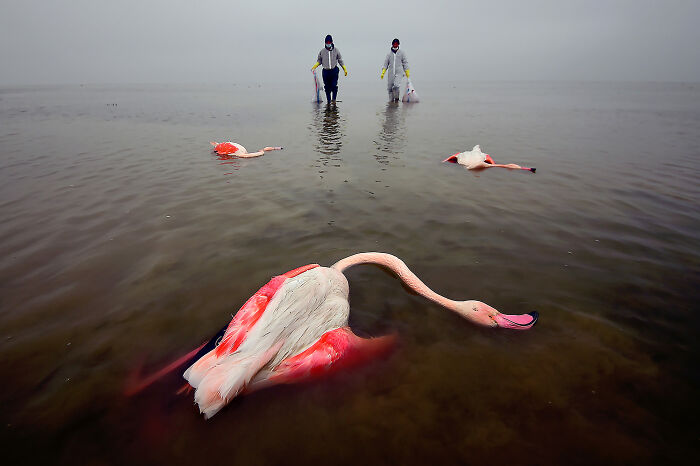
Image credits: epoty.org
#14 "I'm Watching You Everywhere" By Maciej Krzanowski, 2021
Suwałki, Poland "Photo shows a small lake hidden within the woods. The lake and its surroundings form a shape of an eye symbolizing that nature is looking into us constantly."
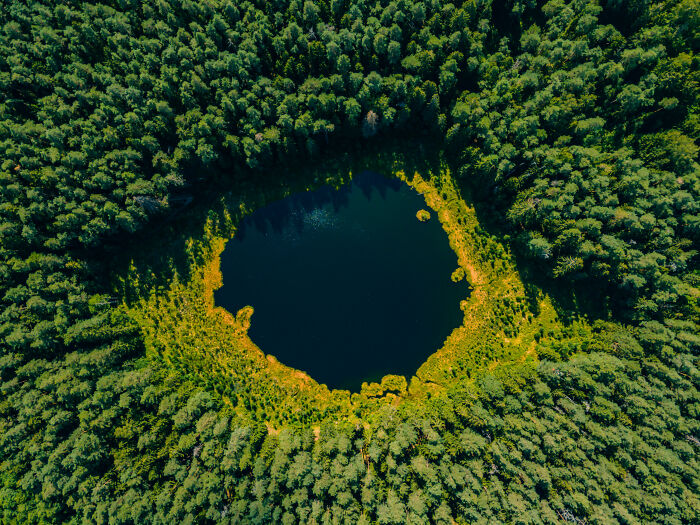
Image credits: epoty.org
#15 "Tears" By Easa Lebbe Muhammed Jamsith, 2022
Oluvil, Sri Lanka "The elephant was unable to stand up, writhing in pain. The employees of the garbage dump helped until the arrival of the wildlife officials, the park officials, the wildlife organization Wildlife and Naturerotection Society Sri Lanka, and the Wildlife and Nature Protection Society. They reached the spot within 3 hours along with a wildlife doctor. Elephants can become addicted to the many types of food found in the rubbish. When those elephants smell food it doesn't matter if it's wrapped in paper or covered in polythene, they swallow everything. After that the waste gets trapped in the elephant's stomach and causes a very painful death for the elephant without being digested."
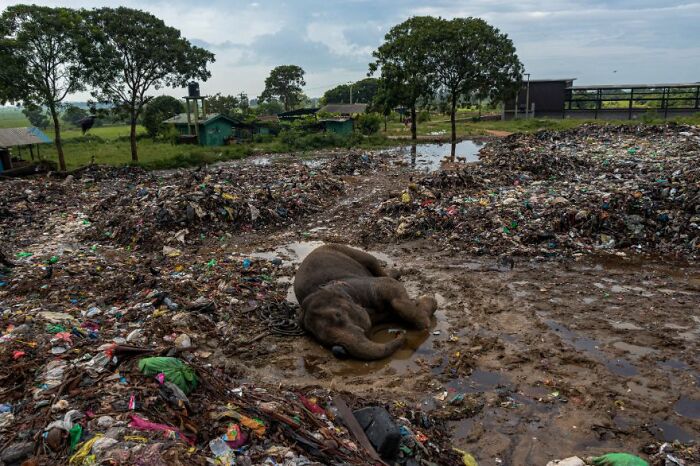
Image credits: epoty.org
#16 "Aceredo" By Brais Lorenzo Couto, 2022
Aceredo, Spain "The village was buried in the 1990s by the waters of the Lindoso reservoir, near Lobios, Ourense. Four other villages were flooded in this Galician region: A Reloeira, Buscalque, O Bao and Lantemil. The normally submerged ruins of Aceredo emerged due to the low water level of the reservoir. Scientists warn that Europe could be suffering its worst drought in 500 years, with its most important rivers drying up."
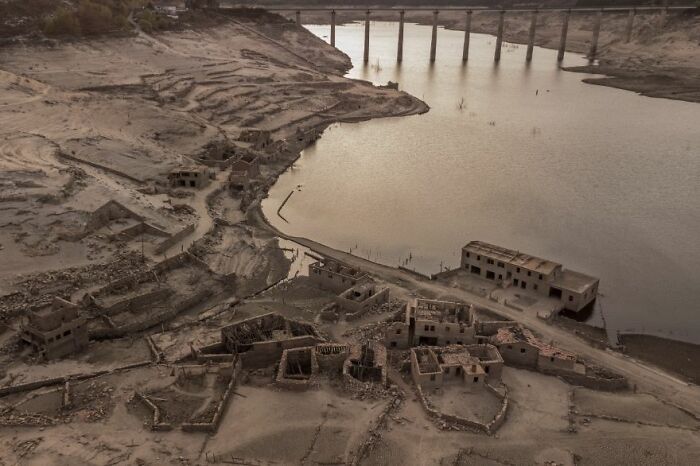
Image credits: epoty.org
#17 "New Ways To The Future (III)" By Simone Tramonte, 2021
Copenhagen, Denmark "A view of Middelgrunden offshore wind farm from Amager Strand, a very popular beach in Copenhagen. The wind farm landscape perfectly integrates with this very popular beach where local people go to sunbathe or play water sports. The wind farm was developed with the strong involvement of the local community in the planning phase and as investors. 14.4% of the Danish electricity consumption is provided by wind. More than 150,000 Danish families are members of wind turbine cooperatives such as this one."
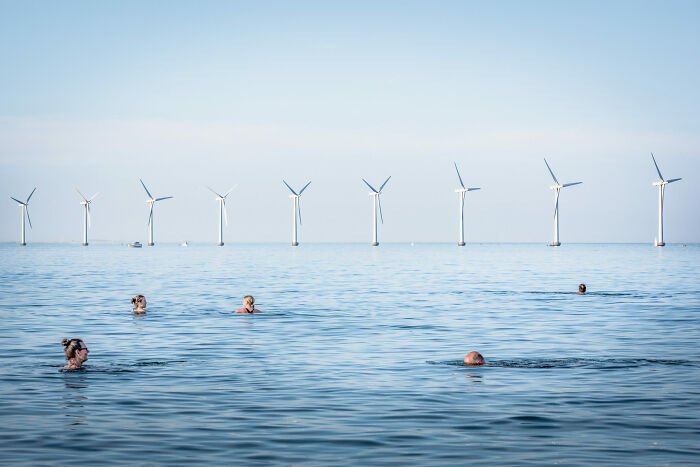
Image credits: epoty.org
#18 "Bio Mining With Trommel Machine" By Sujan Sarkar, 2022
Cooch Behar, India "The decomposition of waste in city landfills causes air pollution and creates a high risk of producing methane under high temperatures, which can lead to a fire. To avoid these unwanted environmental hazards, the Municipal Corporation of Cooch Behar installed Trommel machines to bio-mine the solid waste. The machine removes plastics, sand, metals, etc. from the garbage, which is then recycled and used for tarring, construction, etc. The other waste is converted into organic manure and growth stimulators. Biomining is a scientific process of excavation, treatment, segregation, and gainful utilization of aged solid waste. The machine helps to decrease landfills that accumulated over around 50 years."
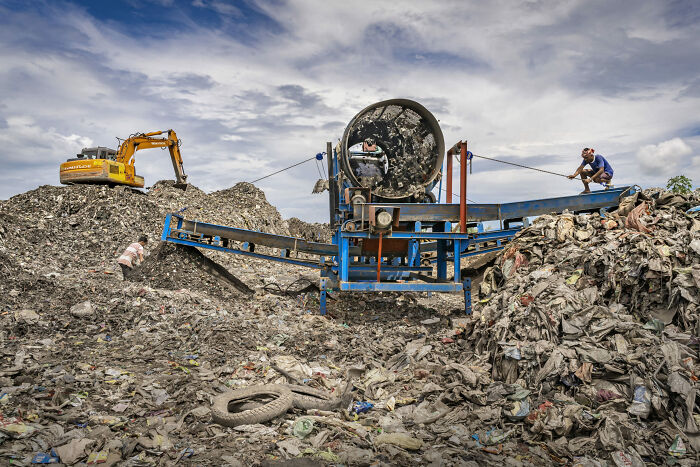
Image credits: epoty.org
#19 "Ecologie Moderne" By Thomas Jean, 2021
Brussels, Belgium "The presence of storks in the European capital is mainly due to the potential food sources, which are linked to our management of organic waste. Unfortunately, I could not intervene in this situation to free the stork simply because it could still fly: it did not let itself be approached. I contacted the special wildlife unit of the Brussels fire brigade and the refuge of the bird protection league. Both replied that they were not able to intervene in this type of case due to a lack of logistical and human resources for this scenario. I hope that this photo will allow things to evolve more positively."
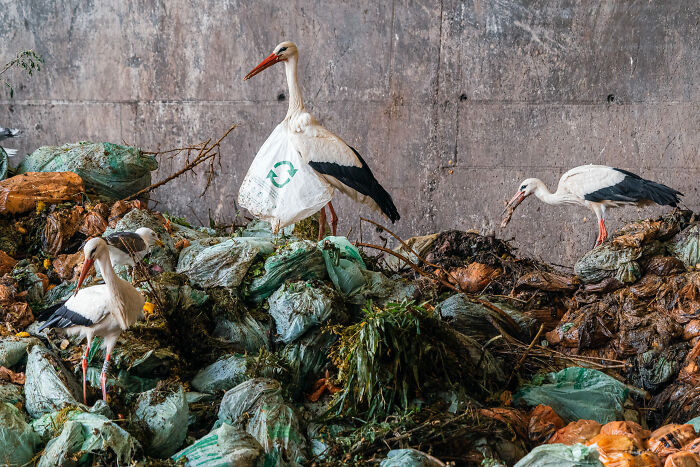
Image credits: epoty.org
#20 "Beautiful But Hostile Colours On Earth" By Fayz Khan, 2022
Southern Rift Valley, Kenya "Lesser flamingoes photographed over Lake Magadi and Lake Natron. The two water bodies were once a single freshwater lake but today the two lakes are highly concentrated salt pans, severely alkaline and toxic to most forms of animal and plant life. The lesser flamingoes are an exception because of their biological makeup, and the birds love to feed on the algae that thrive on the surface. As beautiful as the colors may be, the different hues relate to the algae which change in color as a result of reacting to the differing levels of the alkaline content of the lakes."
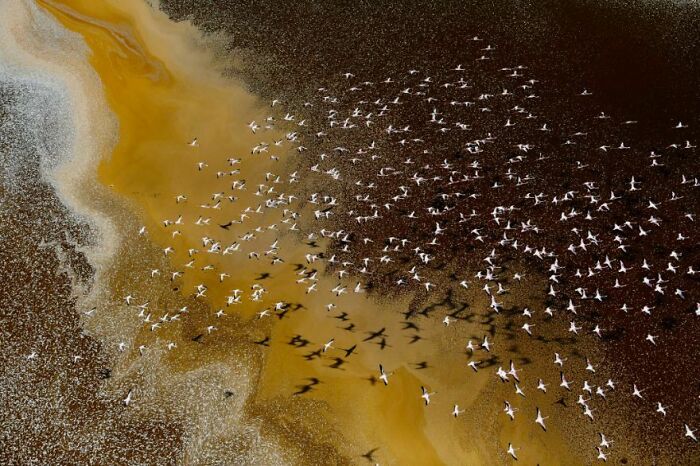
Image credits: epoty.org
#21 "Glacial Cityscape" By Jonas Beyer, 2022
Svalbard, Norway "Looking straight down on a glacier front you can see the shadow from the glacier almost depicting a cityscape, skyscraper, or a huge city. I find the changes we see in the arctic scary, how fast the ice melts in the spring, how fast the glaciers are retreating, just how warm the summers get."
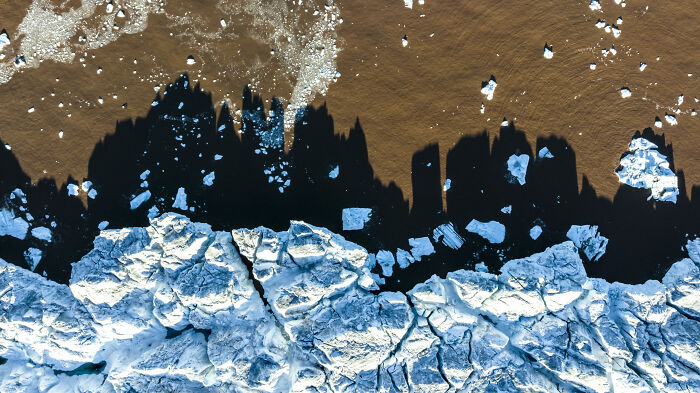
Image credits: epoty.org
#22 "People At Work" By Jignesh Chavda, 2021
Ahmedabad, India "A group of electricians repairs a power line in the late evening after a cyclone hit the city."
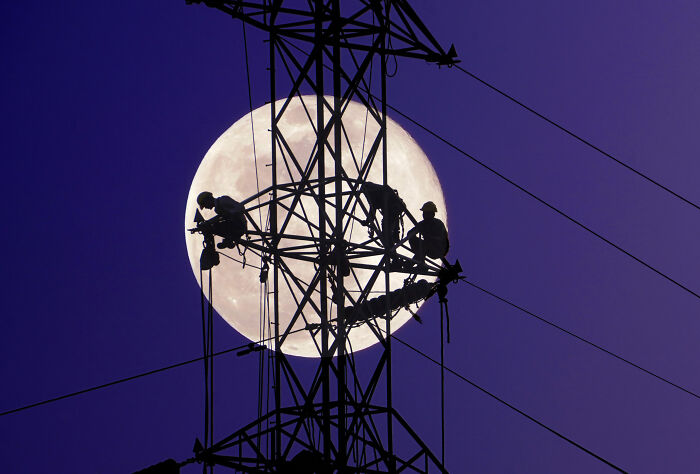
Image credits: epoty.org
#23 "Lilies Of Bengal" By Sandipani Chattopadhyay, 2022
Nabadwip, India "Local villages collect flowers to sell at the market: red lilies are used for home decorations and in vegetable curries. Wild blooms of red lilies were rare in India, they need humid and fresh monsoon water to bloom. Due to adequate rainfall, the bodies of water are recovering, so over the last few years, red water lilies are visible during the monsoon. Nature is slowly recovering and red lilies are the evidence of the same."
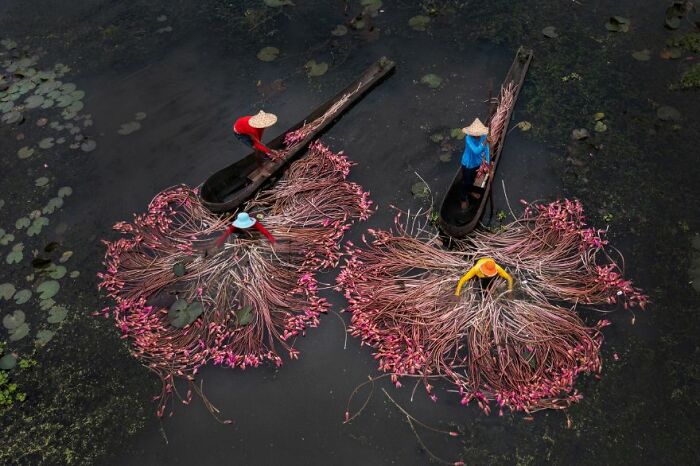
Image credits: epoty.org
#24 "Ecofriendly Jute Processing" By Ahsanul Haque Nayem, 2022
Natore, Bangladesh "Patterns are created on the calm surface of a lake during the first step in the extraction of soft jute fibers, as sliced-up plants are soaked in water for about 15-20 days. The water makes the plants rot, initially turning them orange and then white. This process makes it easy to separate the jute from the plant. Jute (also known as golden fiber) is one of the most eco-friendly and sustainable crops. The government has been nurturing the industry through continuous support and favorable policies and incentives, creating investment opportunities for local and international investors."
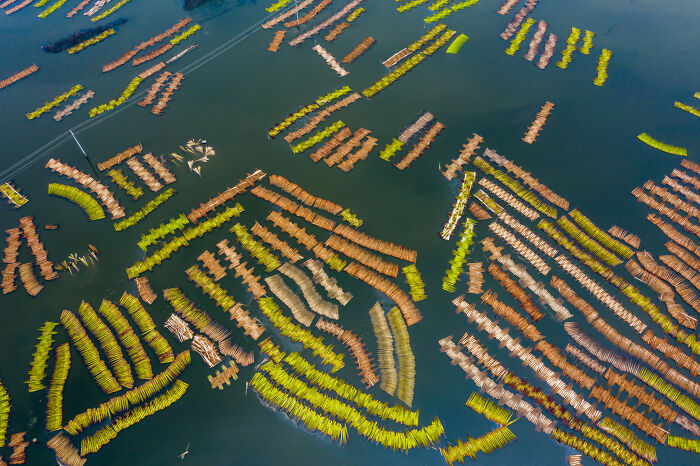
Image credits: epoty.org
#25 "Floating Timber Market" By Pinu Rahman, 2021
Barisal, Bangladesh "The biggest floating timber market in the country is a source of livelihood for many. Dozens of boats crowd the river, with much of the trade occurring without a foot being set upon the land. But lack of sustainable planning and conservation poses a serious threat to the environment. This is particularly devastating for the coastal areas, where trees can mitigate the impact of natural disasters like floods and cyclones."
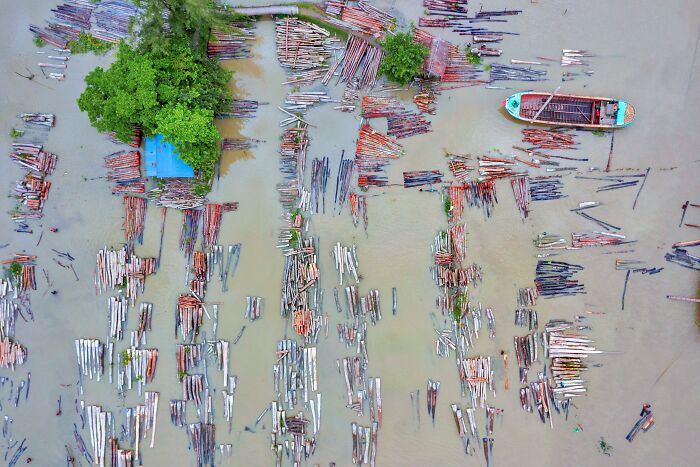
Image credits: epoty.org
#26 "Clearing In Binning Woods" By Andrew Smith, 2022
East Linton, Scotland "These woods were originally planted in 1707 but were clear felled between 1942 and 1945 to fuel the war effort. Afterward, rather than turning the land into farmland, in what is rich agricultural soil, it was replanted in 1960 to be enjoyed by the public and as a haven for wildlife. They now team with badgers, rabbits, hares, buzzards, deer and all manner of insects, birds and small animals. The ponds are well-maintained and include frogs, dragonflies and small fish. Part of the wood is also a green burial site, offering an environmentally sound alternative to a traditional cemetery."
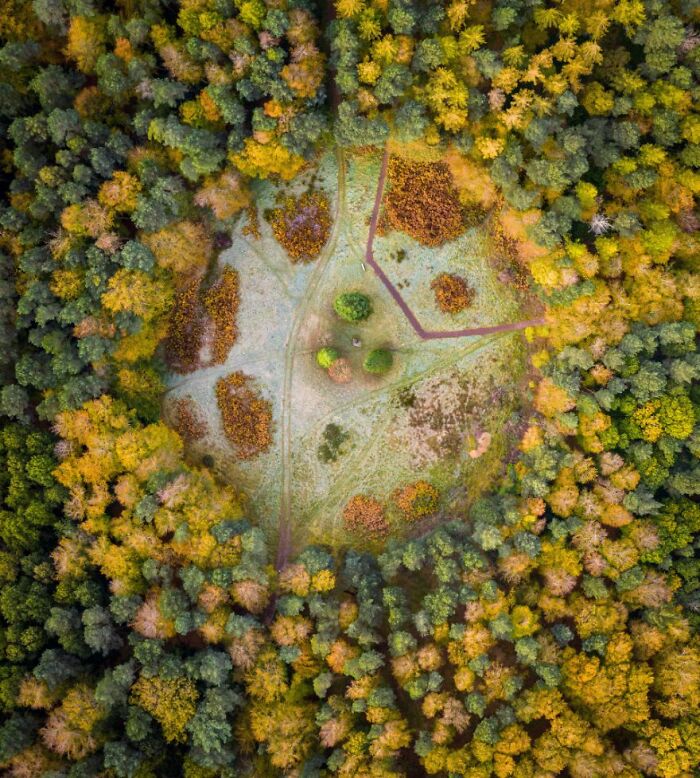
Image credits: epoty.org
#27 "Clean Energy" By Pedro De Oliveira Simões Esteves, 2022
Serra da Arada, Portugal "Up on the mountains in Portugal near some wind turbines watching the sunrise over a sea of clouds."
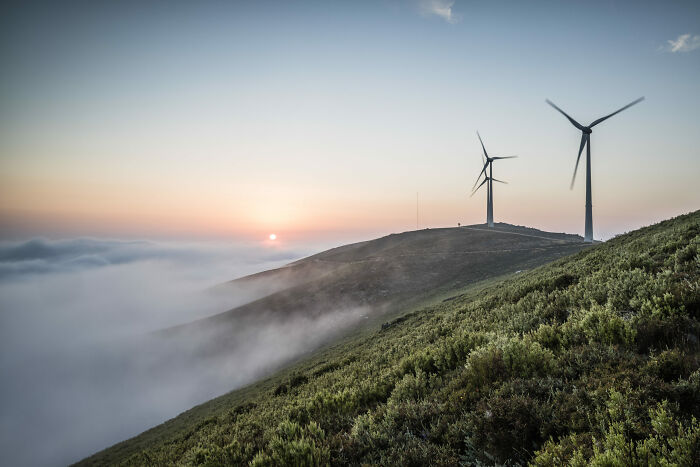
Image credits: epoty.org
#28 "Lithium Evaporation Ponds" By Matjaz Krivic, 2022
Salar de Uyuni, Bolivia "Bolivia's YLB industrial lithium production plant pumps lithium-rich brine into these large evaporation pools on the southern edge of the Salar de Uyuni, where it is left to evaporate for many months. Lithium is the core component of modern batteries. The supply of lithium is not fast enough to accommodate the demand, with Chinese, Australian and American corporations buying lithium mines around the world. Locals are amongst the most vocal critics. Evaporation ponds draw heavily on the already scarce water resources in a dry and high-altitude region. Lithium pollution is an increasing problem wherever it is mined."
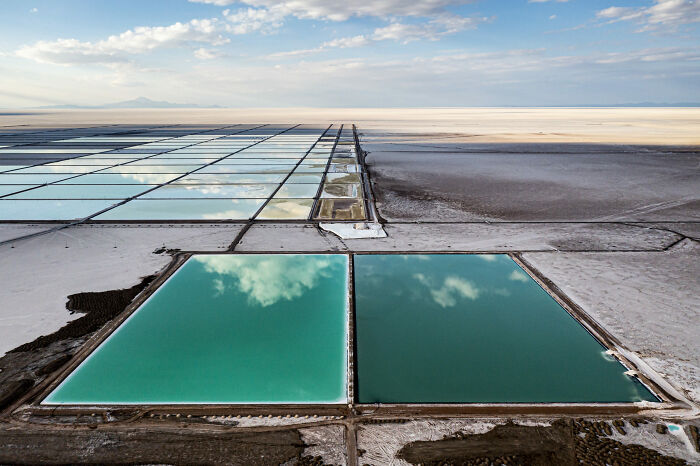
Image credits: epoty.org
#29 "Mutual Assistance Between Man And Nature" By Alex Cao, 2021
Binh Thuan, Vietnam "Bau Ca Cai is an old white-flowered mangrove, planted in the natural breakwater to improve the ecological environment under climate change and sea-level rise. This project is sponsored by the Green Climate Fund and UNDP (United Nations Development Programme), and helps to strengthen resilience to the impacts of climate change for vulnerable communities. The project supports ecotourism and contributes to income improvement and sustainable poverty reduction."
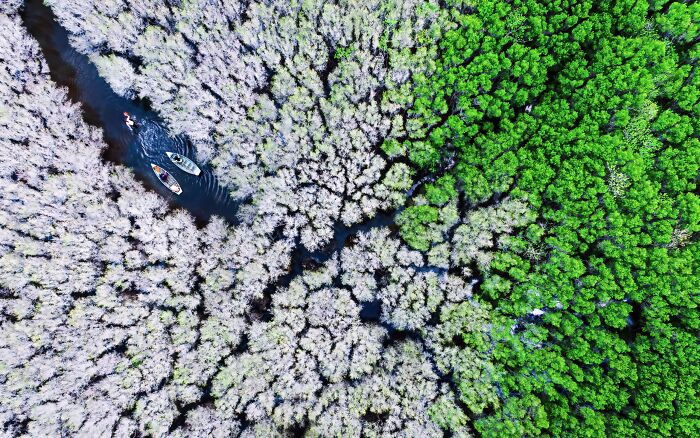
Image credits: epoty.org
#30 "Pyramids Against Drought" By Roberto Bueno, 2021
Bellmunt del Priorat, Spain "The image shows a pyramid at the Priorat fields, a Spanish region known for the quality of its wines. The fields are shaped with pyramid slopes built with laser precision to optimize the amount of water needed by the vineyards. Engineering is helping farmers to make the best use of lands and water, especially in the recent years when droughts are more pronounced."
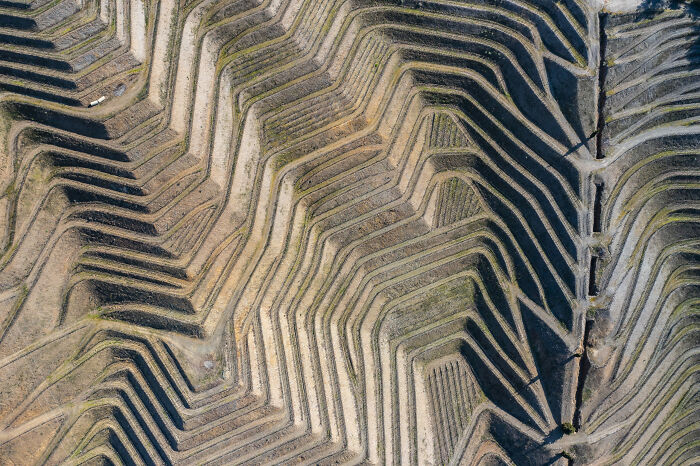
Image credits: epoty.org
#31 "A Story Of A Dried River" By Azim Khan Ronnie, 2022
Manikganj, Bangladesh (08/01/2022) "The once vibrant Kaliganga river has almost dried up in the Tora Bridge area of Manikganj, Bangladesh. The level of water in the river remains very low throughout the year, except during the rainy season. Several chars have emerged from the 78 km-long water body. Green activists blame encroachment on river land and the absence of dredging for the poor state of the river. These were the places where big boats and launches used to ply in the 1960s, said locals."
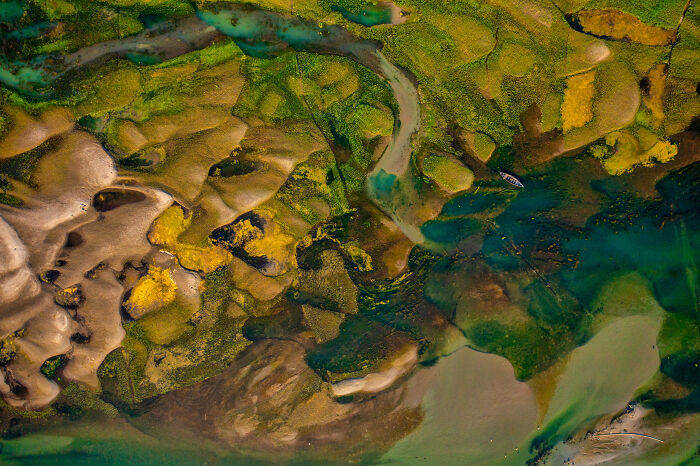
Image credits: epoty.org
#32 "Drying Paddy" By Dibyendu Biswas, 2021
Kalna, India "Manual paddy drying has become a very rare thing, but it is still practiced by the people of Kalna Village. Modernization would mean that all these manual laborers become jobless. This method of manual paddy drying is also environment friendly."
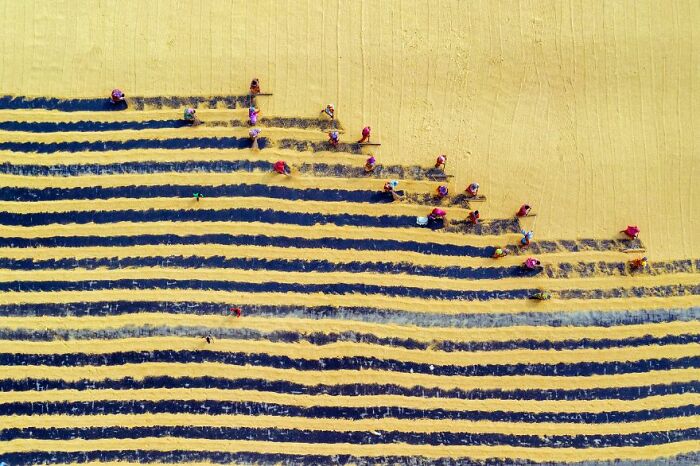
Image credits: epoty.org
#33 "Vineyard In Lanzarote" By Gérard Lüthi, 2021
Lanzarote, Spain "Lava field and walls built in lava stones. More than a quarter of the island is covered with lava and the inhabitants have adapted their cultivation techniques perfectly to the difficult weather conditions: high heat, high winds, and scarcity of water. The walls allow plants to receive water from the morning dew and the rare rains while they remain protected from the wind and sun."
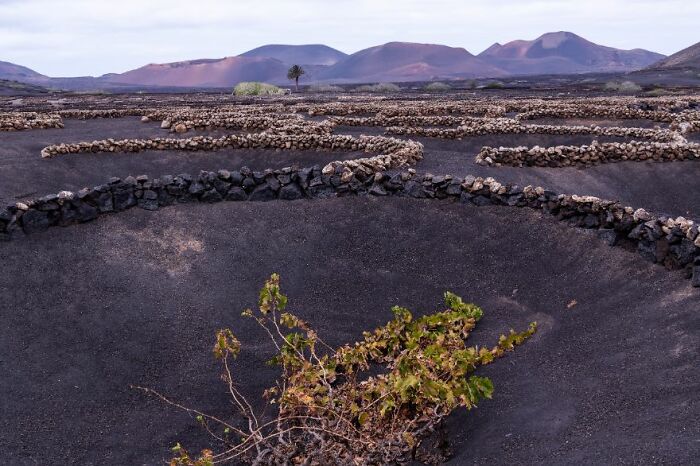
Image credits: epoty.org
#34 "The Environmental Cost Of Fast Fashion" By Muntaka Chasant, 2022
Accra, Ghana "Thousands of discarded pieces of fast fashion waste washed up on the coast of Jamestown in Accra, the capital of Ghana. The vast bulk of the cheap trend-driven mass-produced clothes arrive in Ghana as waste and are unsellable. On the beaches, they decompose and emit methane gas, worsening the climate crisis. According to McKinsey, the fashion industry accounted for 4% of the global greenhouse gas emissions in 2018: the same amount of emissions as Germany, France, and the United Kingdom combined."
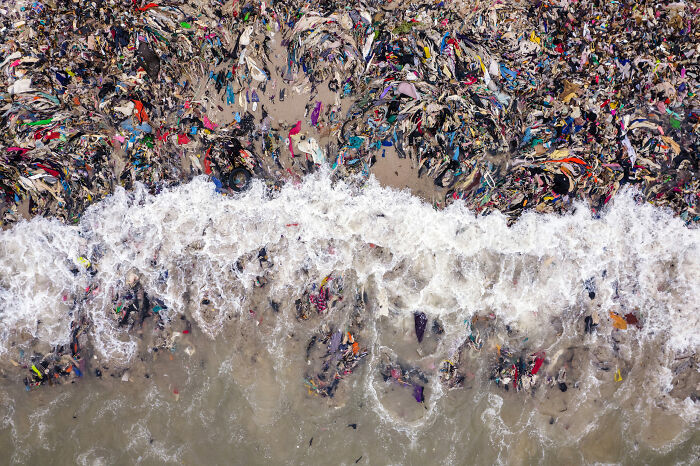
Image credits: epoty.org
#35 "Human Impact On The Environment" By Md Mudassir Hossain, 2021
Dinajpur, Bangladesh "Brick production is an important industry in Bangladesh. Approximately, 1 million people directly or indirectly work at around 7000 brick kilns. The number of brick kilns is increasing every year due to the rising demands for infrastructure development. Brick kilns contribute to the pollution of major cities and even rural areas. They emit carbon dioxide and other harmful gases."
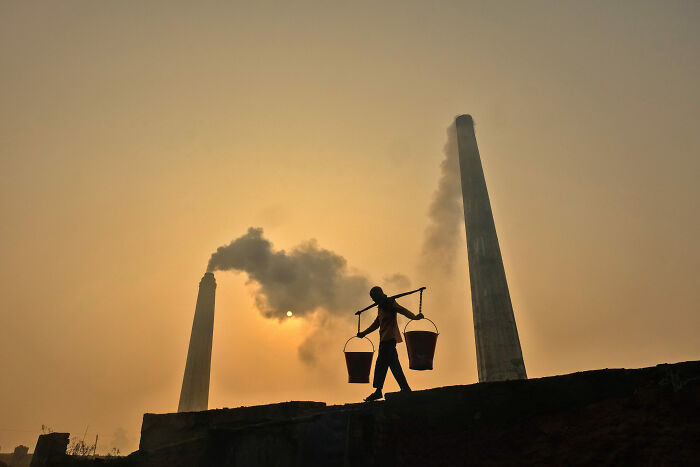
Image credits: epoty.org
#36 "Green Tide" By Yann Avril, 2021
Binic, France "This aerial photo was taken with a drone above Binic beach (Brittany) in France. The sea and the sand are covered with green algae. The waters are saturated with nutrients on which the algae feed, phosphorus and nitrogen which result directly from the nitrates of industrial agriculture. Their proliferation poses a serious environmental problem since it can cause the suffocation of aquatic fauna and flora. It also poses a serious threat to public health. In the 1960s, the average nitrate level in Breton waters did not exceed 5 mg/litre. Today, it is estimated at around 33 mg/litre. This rate peaked in the 2000s at around 50 mg/litre before gradually decreasing. It has now been stagnating for more than three years."
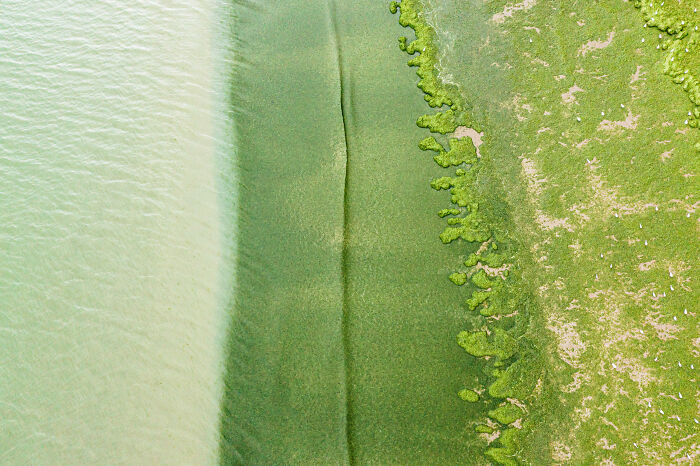
Image credits: epoty.org
#37 "Rice Mill Minimalistic" By Dibakar Roy, 2022
Habra, India "People are stretching and pulling golden paddy to dry at a rice mill in Habra, India. Our India is an agriculture-based country. In most of the rural part of India agriculture is the main source of income. And here paddy is the main grain. After cultivating the golden paddy, it needs to boil and dry to maintain moisture level and preserve. This boil, dry and preservation process is done in several rice mills. After boiling workers dry it on a big ground for 3 to 4 days. And during this drying process workers create many lines and patterns on the ground with this golden paddy. Here are some of these beautiful moments of lines and patterns creations. I have clicked these shots at Habra, W.B. India. In Habra, there are so many places where people are involved in this job. I have taken these shots with my Sony ILCE 7c camera with a Sony 28-60mm lens from the rooftop of a nearby rice mill. Though this drying process happens on a big ground you need a wide-angle lens and I prefer my 28-60mm lens for this. If you want to capture these patterns and lines you have to take the top shot view of these moments, that's why I have chosen the rooftop to click these shots. I went there very early in the morning and took these shots till noon."
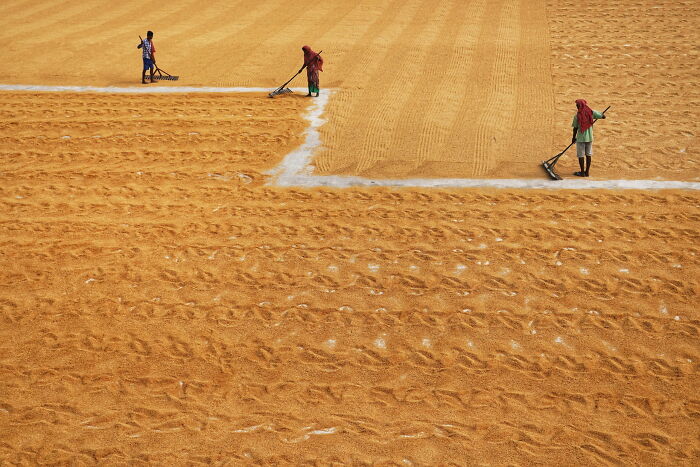
Image credits: epoty.org
#38 "Agro Photovoltaic" By Cesare Barillà, 2022
Piacenza, Italy "Piacenza is a purely agricultural province, with countless crops. The basic idea of agrovoltaics is to ensure that agricultural land can be used to produce clean electricity, leaving room for agricultural crops. The studies carried out in collaboration with the University of Piacenza resulted in a better understanding of the impact that the shadow generated by the photovoltaic modules has on the growth of various agricultural products."
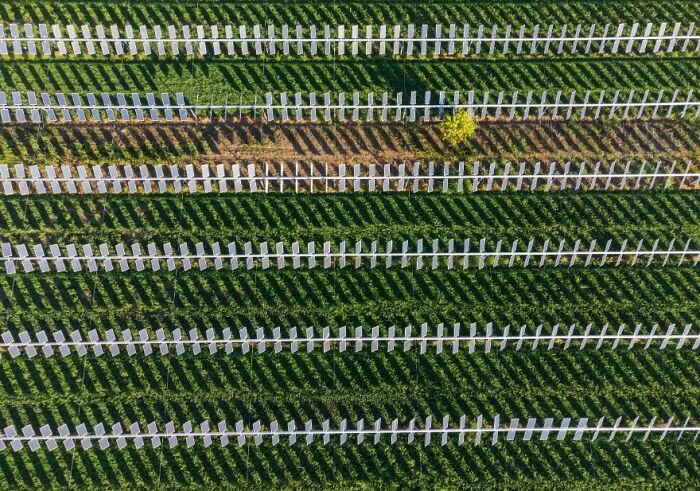
Image credits: epoty.org
#39 "Vertical Farming" By Arie Basuki, 2022
Depok, Indonesia "Officers maintain vegetable crops in a warehouse at Sentra Farm. Various vegetables such as curly lettuce, romaine, clave green, siiomak, kailan and others are cultured in a room where the light and temperature remain stable. The advantage of vertical farming is that it is free of pesticides with a harvest period of only 30 days and an average yield of 20 to 30 kg of vegetables/day."
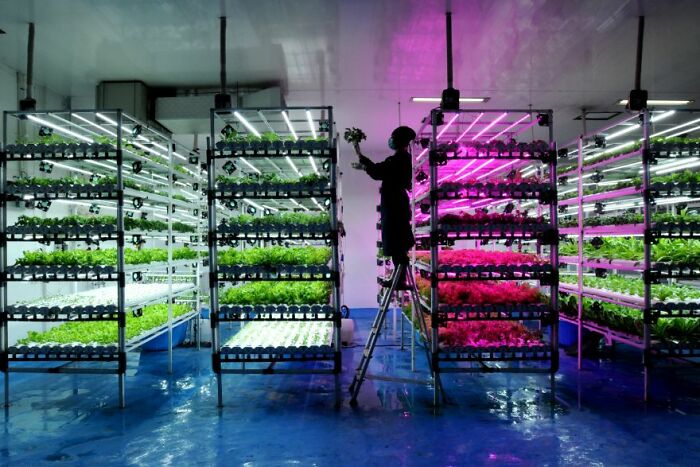
Image credits: epoty.org
#40 "The Chimneys" By Pawel Zygmunt, 2022
Dublin, Ireland "Panoramic view of Dublin Port entrance with old Poolbeg Power Plant. In 2006, the ESB advised of its intention to withdraw approximately 1,300 MW of total Irish electricity capacity by 2011. This effectively reduced the electricity capacity in the country from 6,437 MW to 5,150 MW. The closure was aimed at the older inefficient power stations in Ireland, such as the 3 thermal units at Poolbeg Generating Station that can generate a combined 461 MW of electricity capacity. The newer 460 MW combined cycle fossil gas turbine at Poolbeg would remain operational."
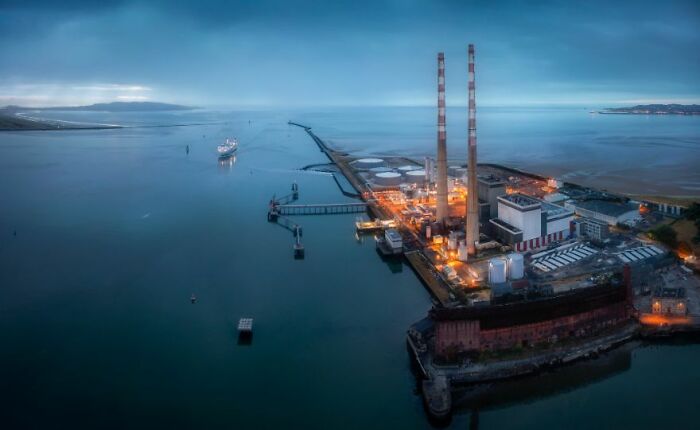
Image credits: epoty.org
#41 "Energy" By Pedro De Oliveira Simões Esteves, 2021
Serra da Arada, Portugal "Up on the mountains in Portugal near some wind turbines moments before sunrise over a sea of clouds."
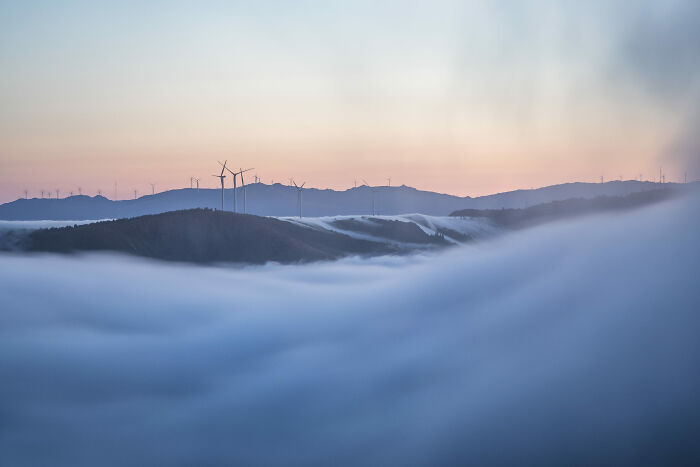
Image credits: epoty.org
#42 "Polluted Planet" By Sebastian Bühler, 2022
Bosnia and Herzegovina "The picture shows a wild garbage dump in the middle of the mountains of Bosnia and Herzegovina. The waste pollutes and endangers the natural habitat of animals and plants. It is estimated that there are around 10,000 larger and smaller illegal garbage dumps in Bosnia and Herzegovina."
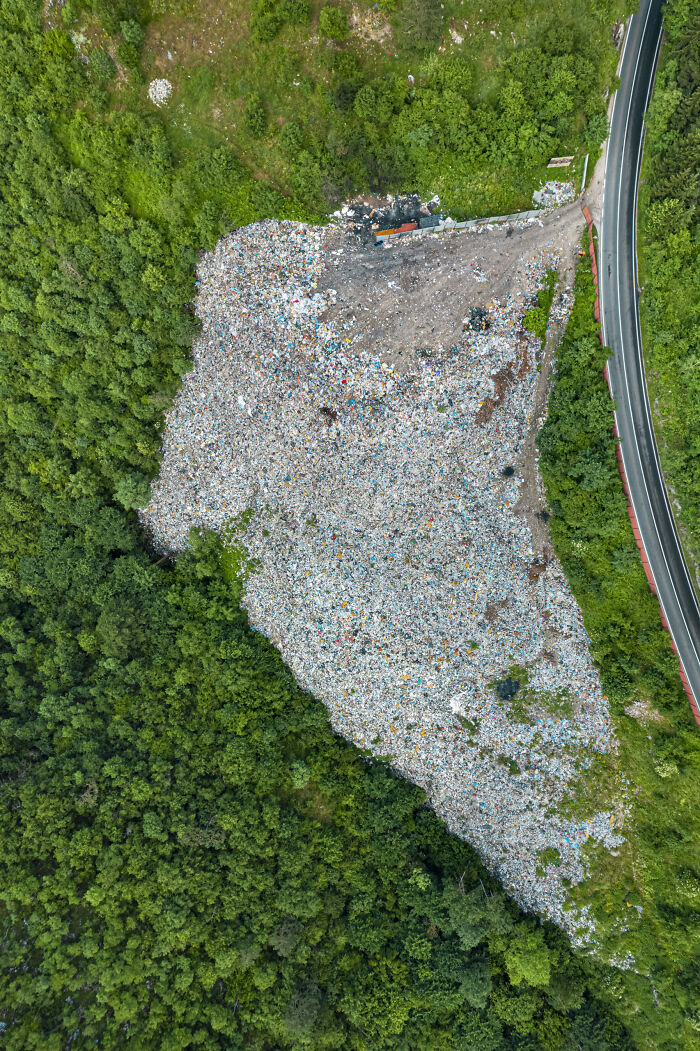
Image credits: epoty.org
#43 "Naturalia: Chronicle Of Contemporary Ruins" By Jonathan 'Jonk' Jimenez, 2021
Pisa, Italy "The photographer wants to ask a fundamental question: what is the place of mankind on Earth and what is our relationship with nature? Far from being pessimistic, and at a time when humanity's domination over nature has never been so extreme, this photo aims to wake our consciousness."
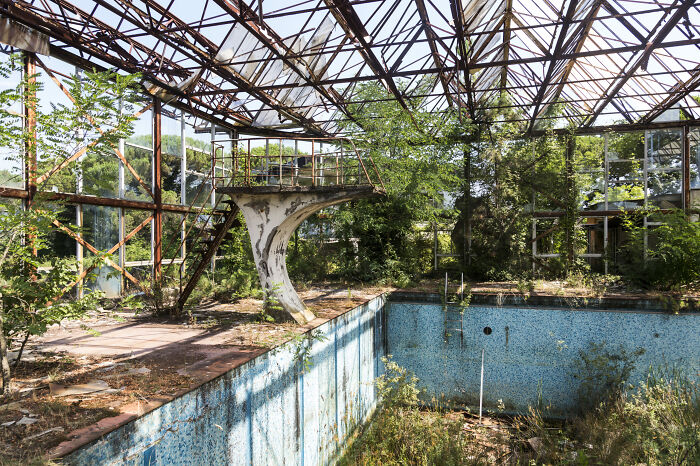
Image credits: epoty.org
#44 "Life" By Shibasish Saha, 2021
West Bengal, India "This image was taken in the rural areas of the wetland. The people documented in this image used to do farming but during the monsoon season when the land gets filled with water, they adapt to fishing for their daily wages. This is how they adapt to nature accordingly to survive in the world and feed their family members."
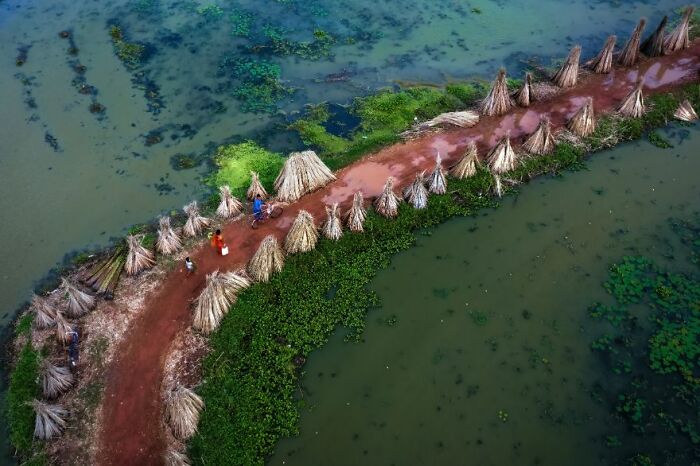
Image credits: epoty.org
#45 "Glacier Calving" By Hira Punjabi, 2022
Svalbard, Norway "Calving is when the snow breaks from the glacier, a process which causes fish and plankton to float up to the surface where birds return to hunt them."
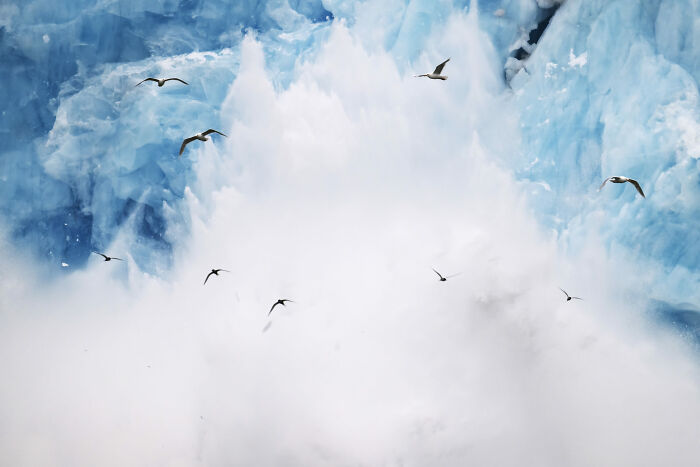
Image credits: epoty.org
#46 "Disappearing Comfort" By Jonas Beyer, 2022
Svalbard, Norway "A polar bear at 82.3 degrees north is searching its surroundings. As the summer gets uncomfortably warm in the high Arctic the less and less solid drift ice is breaking up and decreases the hunting ground for polar bears."
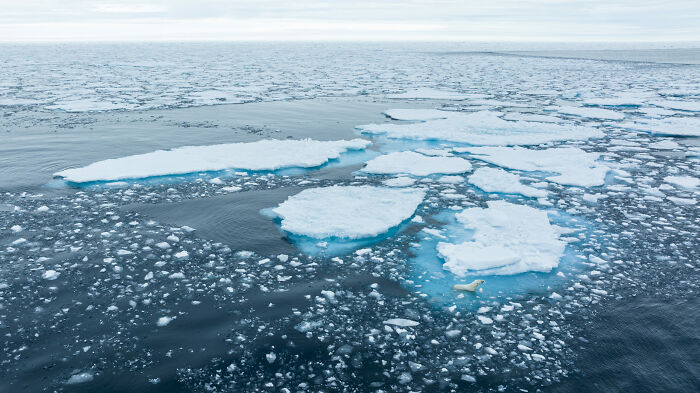
Image credits: epoty.org
#47 "Offshore Wind Resolution" By Neil Ever Osborne, 2021
Block Island, USA "Will Fancher, a Rope Access Supervisor, conducts routine maintenance on a turbine blade at the Block Island wind farm. Developed by Deepwater Wind, construction of the Block Island wind farm began in 2015 and in late summer 2016 five Alstom Haliade 150-6-MW turbines were erected before operations launched in December of the same year. Block Island wind farm started as a demonstration site and remains the largest project using wind power in Rhode Island, USA. NB: Will Fancher was conducting dangerous tasks during the making of this photo; I sought his permission to take all photos of him."
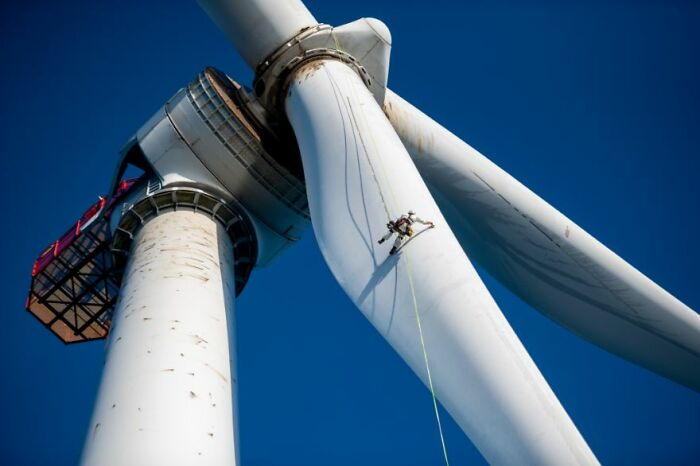
Image credits: epoty.org
#48 "Solar Is The Key" By Gaeus Lazar Tumlos Osilao, 2022
San Jose Del Monte Bulacan, The Philippines "My neighbor Joeward started using a solar panel to decrease energy costs after the Covid-19 pandemic."
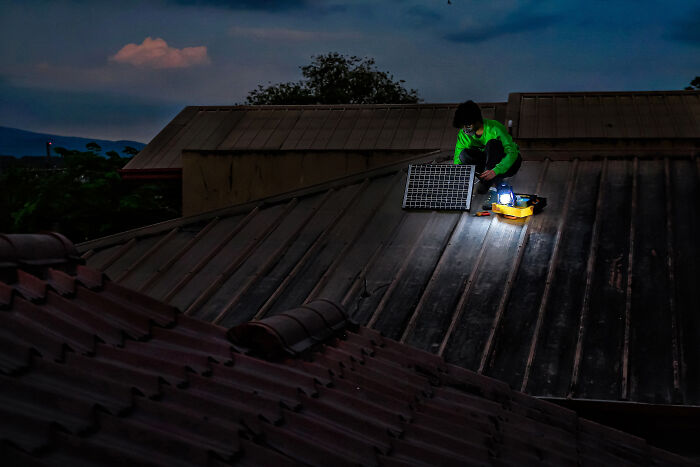
Image credits: epoty.org
#49 "Rain" By Anders Thøstesen, 2022
Puerto Nariño, Colombia "This indigenous village is located on the shore of the Amazon River. Each year, when the rainy season starts, the river rises up to fifteen meters and grows to be several kilometers wide, extending into the forest and riverside settlements. Plants and animals long ago adapted to this extreme change, as did humans. Some houses and pathways are built on stilts, while others are built on immense floating logs to follow the river up and down. Ironically, the newest additions to the village are the concrete paths and the slightly visible park, which are the most vulnerable."
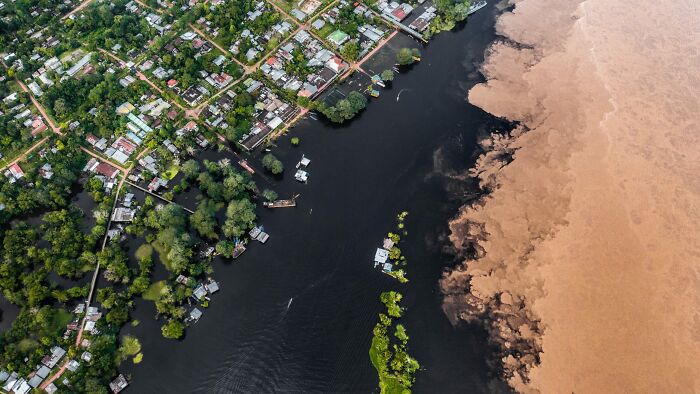
Image credits: epoty.org
#50 "From The Second World War" By Michele Lapini, 2022
Isola degli Internati, Italy "In Gualtieri near Reggio Emilia, two ships that were sunk by the German army during World War II have emerged from the low water levels. It is not the first time they have been seen but this time they reappeared in March when they are usually only seen in August. The levels and flow rates of the Po River are below the emergency thresholds, with values that have not been recorded for at least 70 years; in some areas the flow rates are below historical lows. This scenario is not expected to see any improvement in the next year. Agriculture and drinking water will be affected. On 4 July 2022, the Italian government declared a state of emergency in five regions in northern Italy."
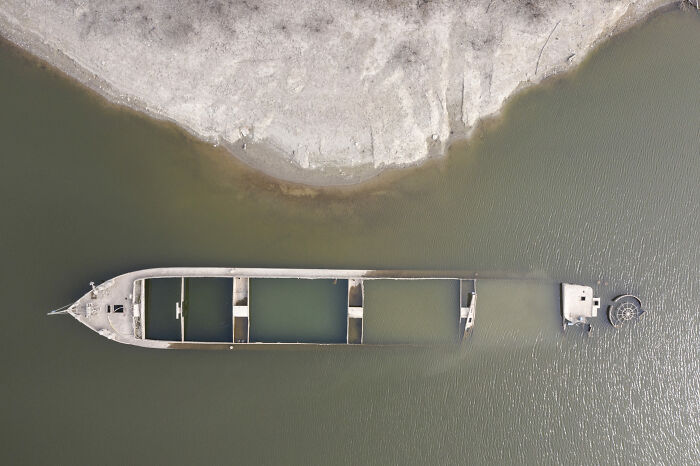
Image credits: epoty.org
#51 "Light" By Pedro De Oliveira Simões Esteves, 2021
Serra da Arada, Portugal "Up on the mountains in Portugal near some wind turbines at sunrise over a sea of clouds."
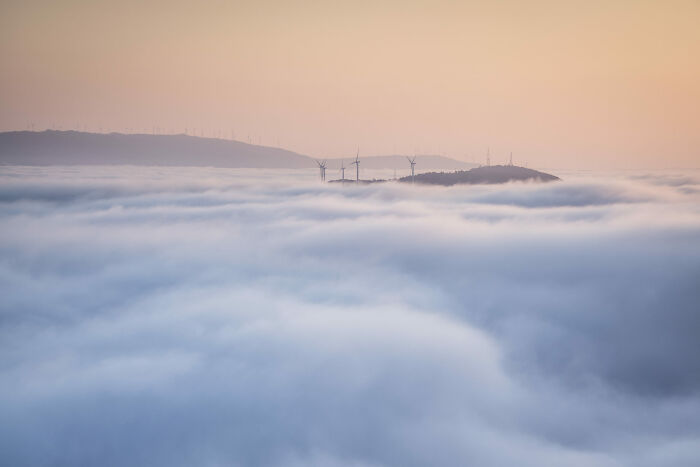
Image credits: epoty.org
#52 "Hope" By Niamul Rifat, 2022
Barishal Division, Bangladesh
"Hundreds of Geotextile bags remain at the bank of the river Kironkhola in Barishal, Bangladesh to save the erosion-prone part of the river. Locals said, about 120 families have been displaced from the village of Charkawa during the past couple of years and among them, a large number chose Dhaka, the country's capital.
According to a report by the state-funded Center for Environmental and Geographic Information Services, from 1973 to 2017 Bangladesh lost more than 162,000 hectares of land (400,310 acres) - double the size of Singapore - to three of its largest rivers. Although the sandbags won't give a permanent solution to stop the climate change-triggered erosion, people living by the riverbanks are seeking a 'Hope' in them."
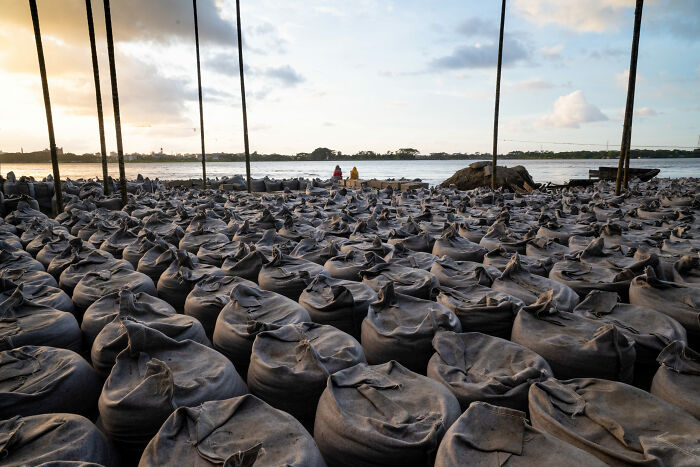
Image credits: epoty.org
#53 "The Duck Herder" By Muhammad Mostafigur Rahman, 2021
Sunamganj, Bangladesh "A farmer raises ducks at The Tanguar Haor in Sunamganj's Tahirpur Upazila in Bangladesh. An increase in the number of domestic ducks is becoming a major threat to this fragile wetland ecosystem, which is a Protected Area and Bangladesh's only second Ramsar Site after Sundarbans."
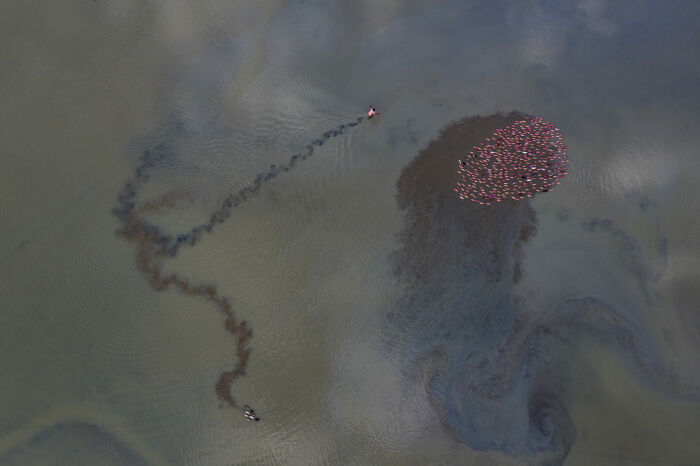
Image credits: epoty.org
